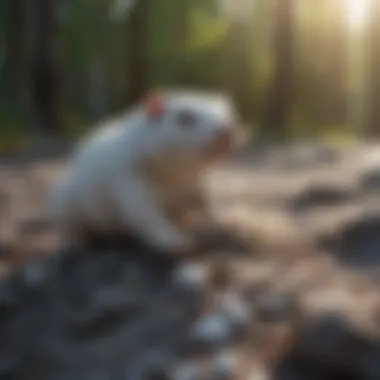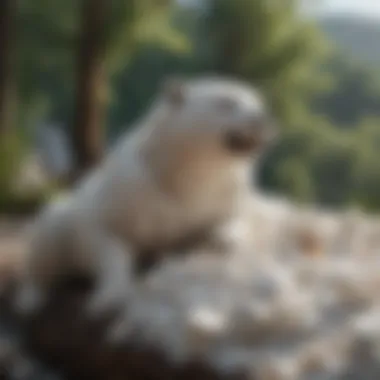Unveiling the Truth: Can Styrofoam be Recycled?


Overview of the Topic
Styrofoam, also known as polystyrene, is a widely used but environmentally harmful material that poses significant challenges in the recycling industry. Its lightweight nature and insulating properties have made it popular in packaging and food service industries, contributing to its widespread usage and subsequent disposal concerns. Understanding the complexities of recycling styrofoam is crucial for promoting sustainable waste management practices and reducing environmental impact.
Current Status and Challenges
The current state of styrofoam recycling remains inefficient and challenging due to several factors. One major obstacle is the lack of adequate infrastructure for collecting, sorting, and processing styrofoam waste. Furthermore, the lightweight nature of styrofoam makes it uneconomical to transport in bulk, leading to increased transportation costs and carbon emissions. Additionally, contamination from food residues and other substances further complicates the recycling process, limiting the potential for effective recycling of styrofoam materials.
Sustainable Solutions
Exploring sustainable practices offers promise for addressing the pressing issue of styrofoam waste management. Innovative technologies such as densification machines can compress styrofoam waste into denser blocks, reducing transportation costs and facilitating recycling. Furthermore, implementing extended producer responsibility (EPR) schemes can incentivize manufacturers to take responsibility for the end-of-life disposal of their products, encouraging the development of more eco-friendly packaging alternatives.
Impact and Importance
The impact of styrofoam waste on ecosystems and communities cannot be overstated. Improper disposal of styrofoam leads to pollution of waterways, soil contamination, and harm to marine life, posing grave threats to environmental sustainability. By emphasizing the importance of conservation efforts and promoting sustainable resource use, stakeholders can work towards mitigating the adverse effects of styrofoam waste on current and future generations.
Introduction
The topic of recycling styrofoam holds significant importance in today's world, where environmental sustainability is a critical concern. This section aims to shed light on the various aspects related to styrofoam recycling, highlighting its impact on the environment and the challenges associated with this material. By understanding the complexities of recycling styrofoam, individuals can make informed decisions regarding waste management and sustainable practices.
Understanding Styrofoam
What is Styrofoam?
Styrofoam, also known as polystyrene foam, is a lightweight material widely used for packaging and insulation due to its excellent thermal insulation properties. It is composed of 98% air, making it highly buoyant and resistant to moisture. Despite its widespread use, styrofoam poses challenges in terms of recycling due to its non-biodegradable nature and potential environmental impact.
Common Uses of Styrofoam
Styrofoam finds extensive applications in the packaging industry, as disposable food containers, protective packaging for electronics, and insulation material in buildings. Its versatility and low cost make it a popular choice for various industries. However, the widespread use of styrofoam has raised concerns about its environmental implications, prompting the need for sustainable waste management solutions.
Impact on the Environment
The environmental impact of styrofoam stems from its non-biodegradable nature and poor recyclability. Styrofoam litter can persist in the environment for hundreds of years, contributing to pollution of water bodies and posing threats to wildlife. The production of styrofoam also involves the release of toxic chemicals, further exacerbating its environmental footprint. Understanding these detrimental effects is crucial in addressing the challenges associated with styrofoam waste management.
Recycling Styrofoam
Recycling Styrofoam is a critical topic within the broader context of sustainability and waste management. Styrofoam, also known as Expanded Polystyrene (EPS), poses significant challenges due to its non-biodegradable nature and potential harm to the environment. By understanding the complexities of recycling Styrofoam, individuals can make more informed decisions regarding its disposal. This section delves into the importance of recycling Styrofoam, highlighting the benefits of reducing Styrofoam waste in landfills and exploring sustainable alternatives for its management.


Challenges of Styrofoam Recycling
Lightweight Nature
The lightweight nature of Styrofoam is a double-edged sword in the realm of recycling. While its lightweight property makes it a popular choice for packaging and insulating materials, it also presents challenges during the recycling process. Due to its low density, Styrofoam can easily break apart into small beads or particles, complicating collection and recycling efforts. This characteristic makes handling and transporting Styrofoam for recycling a cumbersome task, requiring specialized equipment and procedures to contain the material effectively.
Contamination Issues
Contamination poses a significant obstacle to the recycling of Styrofoam. The porous nature of Styrofoam allows it to absorb liquids and contaminants, making it challenging to ensure the purity of recycled Styrofoam products. Food residues, dirt, and other substances can adhere to Styrofoam, compromising its quality and recyclability. Addressing contamination issues requires thorough cleaning and processing of Styrofoam before it can undergo recycling, adding complexity and cost to the recycling chain.
Lack of Infrastructure
The lack of appropriate recycling infrastructure further complicates the Styrofoam recycling landscape. Unlike more commonly recycled materials such as plastic or paper, Styrofoam lacks widespread recycling facilities and programs. This dearth of infrastructure hinders the efficient collection and processing of Styrofoam waste, limiting its recycling potential. Developing a robust recycling infrastructure tailored to handle Styrofoam materials is integral to overcoming this challenge and promoting sustainable Styrofoam recycling practices.
Can Styrofoam be Recycled?
Styrofoam recycling is a critical topic in the realm of sustainability and environmental conservation. In this pivotal section of the article, we delve deep into the possibilities and challenges surrounding the recycling of Styrofoam. As we navigate through the complex landscape of waste management, it becomes evident that addressing the recyclability of Styrofoam is crucial for mitigating its adverse impact on the environment. Understanding the feasibility of recycling Styrofoam lays the foundation for implementing effective waste reduction strategies and fostering a culture of responsible consumption.
Existing Recycling Methods
Mechanical Recycling
Mechanical recycling stands as a prominent player in the realm of Styrofoam recycling. Through mechanical processes, Styrofoam waste is collected, sorted, and then melted down to form new products. The mechanical recycling of Styrofoam plays a vital role in reducing the volume of waste destined for landfills. Its eco-friendly nature and cost-effectiveness make it a popular choice for recycling initiatives. However, challenges such as energy consumption and the limitations of recyclability pose significant hurdles to its widespread adoption.
Chemical Recycling
Chemical recycling introduces a revolutionary approach to tackling Styrofoam waste. By employing chemical processes, Styrofoam is broken down into its molecular components, which can then be utilized to create new materials. This method offers a high level of efficiency in converting Styrofoam waste into valuable resources, thereby reducing environmental impact. Chemical recycling presents a promising solution to the challenges posed by traditional recycling methods, as it enables a more sustainable and resource-efficient approach to managing Styrofoam waste.
Expanded Polystyrene (EPS) Recycling
Expanded Polystyrene (EPS) recycling focuses on reusing foam packaging materials to minimize environmental impact. This method involves collecting EPS waste, compacting it, and repurposing it for various applications. EPS recycling plays a crucial role in reducing the carbon footprint associated with Styrofoam production and disposal. Its lightweight properties and versatility make it an attractive option for sustainable waste management practices. However, challenges related to contamination and limited recycling facilities hinder its widespread adoption.
Alternative Solutions
In the realm of recycling, exploring alternative solutions is imperative to combat the challenges associated with Styrofoam waste. The importance of alternative solutions lies in their potential to alleviate environmental impacts and foster sustainable practices. By delving into innovative methods of managing Styrofoam, this article seeks to shed light on pragmatic and effective approaches towards waste reduction. Emphasizing alternative solutions is pivotal in addressing the pressing need for eco-friendly alternatives and promoting responsible consumption habits.
Styrofoam Reuse Ideas


As Packing Materials
The utilization of Styrofoam as packing materials presents a dual-purpose solution for waste reduction and practicality. Its lightweight nature and protective properties make it an ideal choice for ensuring the safe transport of delicate items. Despite its controversial environmental footprint, repurposing Styrofoam for packaging materials offers a sustainable alternative to single-use plastics. The insulating characteristics of Styrofoam also contribute to minimizing heat loss during transportation, thereby reducing energy consumption.
For Art and Craft Projects
Repurposing Styrofoam for art and craft projects taps into its versatility as a creative medium. Artists and DIY enthusiasts can transform discarded Styrofoam into intricate sculptures, props, and decorations, fostering creativity while reducing waste. The lightweight and easy-to-shape nature of Styrofoam make it an attractive material for various artistic endeavors. The use of Styrofoam in art not only encourages resourcefulness but also prompts reflection on the value of upcycling materials in a society preoccupied with disposability.
In Construction
Integrating Styrofoam in construction projects showcases its structural integrity and insulating properties. From filling gaps and providing thermal insulation to enhancing buoyancy in floating structures, Styrofoam's versatility is a boon to the construction industry. Despite concerns regarding its environmental impact, the lightweight and moldable characteristics of Styrofoam offer construction benefits such as ease of installation and resistance to moisture. Leveraging Styrofoam in construction underscores the potential for sustainable building practices and innovative design solutions.
Environmental Impact
When delving into the complexities of styrofoam recycling, the environmental impact stands out as a critical focal point. Understanding the repercussions of styrofoam on the ecosystem is imperative for advocating sustainable waste management practices. By comprehending the gravity of its effects, individuals can make informed decisions to mitigate environmental harm and promote ecological balance.
Effects of Styrofoam on the Ecosystem
Pollution of Water Bodies
The pollution of water bodies due to styrofoam waste poses a significant threat to aquatic life and overall ecosystem health. The non-biodegradable nature of styrofoam leads to persistent contamination, disrupting the aquatic ecosystem's delicate balance. Styrofoam's buoyant properties result in its easy dispersal across water surfaces, where it persists for long periods, releasing harmful toxins and microplastics into the environment. This accumulation of styrofoam debris not only degrades water quality but also poses a direct risk to marine organisms, highlighting the urgent need for responsible disposal and recycling methods.
Threats to Wildlife
The impact of styrofoam on wildlife is profound, as animals often mistake it for food, leading to ingestion and subsequent health complications. The ingestion of styrofoam by wildlife not only impairs their digestive systems but also exposes them to toxic chemicals present in the material. Additionally, entanglement in styrofoam packaging poses physical risks to birds, marine creatures, and terrestrial animals, disrupting their natural behavior and, in severe cases, causing injury or death. Addressing these threats requires concerted efforts towards reducing styrofoam waste generation and implementing effective recycling measures to safeguard vulnerable wildlife populations.
Longevity in Landfills
The longevity of styrofoam in landfills exacerbates waste management challenges, prolonging its environmental impact for hundreds of years. Due to its non-biodegradable composition, styrofoam remains intact for extended durations, occupying significant landfill space and contributing to the accumulation of persistent waste. This extended lifespan not only hinders space utilization but also releases harmful chemicals as it breaks down, perpetuating environmental pollution. Enhancing styrofoam recycling initiatives is crucial to minimizing its presence in landfills and curbing the long-term consequences of this unsustainable disposal practice.
Current Initiatives
Current initiatives play a crucial role in the realm of styrofoam recycling, as they form the bedrock for implementing sustainable waste management practices. These initiatives encompass various programs and efforts aimed at tackling the challenges posed by styrofoam waste. By shedding light on innovative approaches and fostering collaboration, current initiatives pave the way for a more environmentally conscious society. They serve as a beacon of hope for combating the detrimental effects of styrofoam on our planet while promoting green practices.
Recycling Programs
Local Recycling Centers


Local recycling centers emerge as key players in the mission to recycle styrofoam efficiently. These dedicated facilities provide a vital link between communities and the recycling process. Their proximity to residents fosters convenience and encourages participation in recycling efforts. Local recycling centers boast state-of-the-art technology for processing styrofoam effectively. By accepting and processing styrofoam waste, these centers significantly reduce the amount of styrofoam ending up in landfills.
Corporate Sustainability Efforts
Corporate sustainability efforts mark a significant stride towards combating styrofoam waste. Companies across industries are increasingly incorporating eco-friendly practices into their operations. By implementing recycling programs and sustainable packaging initiatives, corporations mitigate their environmental footprint. Corporate sustainability efforts encompass a wide range of strategies, including reducing overall styrofoam usage, promoting reusable packaging options, and investing in green technologies for styrofoam recycling. These endeavors not only benefit the environment but also enhance brand value and corporate social responsibility.
Community-led Campaigns
Community-led campaigns channel the power of collective action towards addressing styrofoam waste. These grassroots movements mobilize individuals and local communities to advocate for sustainable practices and policy changes. Community-led campaigns raise awareness about the impact of styrofoam on the environment and empower citizens to take proactive steps towards waste reduction. By engaging the public through education and outreach programs, these campaigns foster a culture of environmental stewardship. They inspire people to embrace greener habits and play an active role in safeguarding our planet for future generations.
Future Prospects
In the realm of styrofoam recycling, Future Prospects play a pivotal role in shaping the sustainability landscape for this material. It is imperative to consider the advancements and possibilities that lie ahead to mitigate the environmental impact of styrofoam waste. Future Prospects encompass a range of strategies and innovations poised to revolutionize how we perceive and address styrofoam recycling on a global scale. Understanding these prospects is crucial for driving meaningful change and fostering a more eco-conscious approach towards waste management.
Technological Advancements
Innovations in Styrofoam Recycling
Innovations in Styrofoam Recycling represent a significant leap forward in the quest for sustainable waste management solutions. These advancements introduce cutting-edge technologies and methodologies designed to enhance the efficiency and effectiveness of styrofoam recycling processes. One key characteristic of these innovations is their ability to break down styrofoam waste into reusable materials at a molecular level, thereby reducing resource wastage and environmental harm. The unique feature of Innovations in Styrofoam Recycling lies in their capacity to address the inherent challenges associated with traditional recycling methods, offering a more streamlined and eco-friendly alternative for managing styrofoam waste. While these innovations signal a positive shift towards a greener future, it is essential to carefully assess their long-term implications and scalability to ensure widespread adoption and impact.
Biodegradable Alternatives
Biodegradable Alternatives present a promising avenue for reducing the ecological footprint of styrofoam products. These alternatives are characterized by their inherent ability to decompose naturally into non-toxic byproducts, minimizing the long-term environmental consequences of styrofoam usage. The key advantage of Biodegradable Alternatives lies in their capacity to mitigate the accumulation of non-biodegradable waste in landfills and ecosystems, contributing to a more sustainable waste management cycle. However, it is crucial to consider the potential drawbacks of biodegradable materials, such as their production costs and durability, to determine their suitability as viable replacements for traditional styrofoam products.
Policy Developments
Policy Developments play a critical role in shaping the regulatory framework surrounding styrofoam usage and disposal. These developments encompass legislative measures and initiatives aimed at promoting responsible styrofoam management practices and fostering a culture of environmental accountability. The key characteristic of Policy Developments is their potential to enact systemic changes that incentivize businesses and individuals to adopt greener practices and reduce their reliance on styrofoam products. By enforcing regulations that govern the production, distribution, and disposal of styrofoam, these policies contribute to creating a more sustainable and eco-friendly environment. However, it is essential to strike a balance between regulatory enforcement and operational feasibility to ensure effective implementation and compliance across various sectors.
Conclusion
Styrofoam recycling is a critical aspect of sustainable waste management due to its detrimental environmental impact. The disposal of styrofoam poses challenges that necessitate innovative solutions and concerted efforts from individuals and industries. This article sheds light on the urgency of addressing styrofoam recycling for a greener future.
Key Takeaways
Sustainable Disposal Practices
Sustainable disposal practices play a pivotal role in managing styrofoam waste efficiently. Implementing methods such as incineration with energy recovery and chemical recycling can significantly reduce the environmental footprint of styrofoam disposal. The key characteristic of sustainable disposal practices lies in their capacity to minimize waste accumulation while generating useful resources. Despite their benefits, these practices may require specialized facilities and regulatory support for widespread adoption.
Individual Responsibility
Individual responsibility in managing styrofoam waste is paramount for sustainable resource management. By adopting practices like reusing styrofoam packaging and supporting recycling initiatives, individuals can contribute to reducing the overall carbon footprint associated with styrofoam manufacturing and disposal. The unique feature of individual responsibility lies in its direct impact on waste reduction at a grassroots level. However, challenges may arise in promoting widespread awareness and behavioral change among consumers to embrace more eco-friendly practices.
Advocacy for Policy Changes
Advocating for policy changes regarding styrofoam use and disposal is crucial for driving systemic shifts towards sustainability. Enforcing extended producer responsibility laws, promoting eco-friendly alternatives, and incentivizing companies to adopt greener practices are essential steps towards mitigating the environmental impact of styrofoam. The key characteristic of advocacy for policy changes is its potential to influence regulations at a higher level, fostering a conducive environment for sustainable waste management practices. Yet, navigating bureaucratic processes and securing widespread stakeholder support remain key challenges in advancing policy amendments for styrofoam management.



